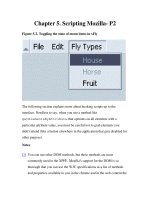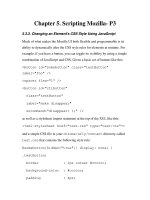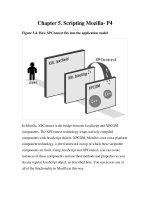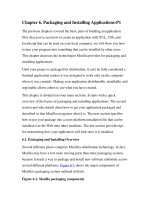Tài liệu Creating Applications with Mozilla-Chapter 5. Scripting Mozilla- P1 doc
Bạn đang xem bản rút gọn của tài liệu. Xem và tải ngay bản đầy đủ của tài liệu tại đây (62.22 KB, 21 trang )
Chapter 5. Scripting Mozilla- P1
In Mozilla, scripting plays important roles in the XPFE. Whether developers
refer to script access and security, user interface logic, XPCOM object
invocation, or script execution in element event handlers, scripting is so
integral to application development that Mozilla, as a development platform,
would be inconceivable without it.
The core scripting language used in Mozilla is JavaScript. Although it has
had a reputation as an unsophisticated language used mostly in web pages,
JavaScript is more like a first-tier programming language. Modularity, good
exception handing, regular expression enhancement, and number formatting
are just some features of the new JavaScript 1.5,[1]
which is based on the
ECMA-262 standard.[2]
JavaScript 2.0, due sometime late in 2002, promises
to be an even bigger promotion of the language.
Three distinct levels of JavaScript are identified in this chapter. A user
interface level manipulates content through the DOM, a client layer calls on
the services provided by XPCOM, and, finally, an application layer is
available in which JavaScript can create an XPCOM component. The
following section describes these levels in detail.
5.1. Faces of JavaScript in Mozilla
As you have already seen in some examples in this book, the user interface
uses JavaScript extensively to create behavior and to glue various widgets
together into a coherent whole. When you add code to the event handler of
one element to manipulate another -- for example, when you update the
value of a textbox using a XUL button -- you take advantage of this first
"level" of scriptability. In this role, JavaScript uses the Document Object
Model (DOM) to access parts of the user interface as a hierarchical
collection of objects. The section Section 5.3
, later in this chapter, discusses
this highest level of scripting.
At a second level, JavaScript glues the entire user interface to the XPCOM
libraries beneath, which create the application core. At this level, XPConnect
(see the section Section 5.4.1
later in this chapter) provides a bridge that
makes these components "scriptable," which means that they can be invoked
from JavaScript and used from the user interface layer. When JavaScript
calls methods and gets data from scriptable components, it uses this second
layer of scriptability.
Finally, at the third and ultimate level of Mozilla scripting, JavaScript can be
used as a "first-order" language for creating the application core itself, for
writing software components or libraries whose services are called. We
discuss this third level of scripting and provide a long example in the section
Section 8.2.1
in Chapter 8.
When you use JavaScript in these contexts, the application architecture looks
something like Figure 5-1
, in which scripting binds the user interface to the
application core through XPConnect and can reside as a software component
using such technologies as XPIDL and XPCOM.
Figure 5-1. Scripting in Mozilla
Notes
[1]
This book does not pretend to give a complete overview of JavaScript. You can
view the full JavaScript 1.5 reference online at
/>[2]
The third edition of the EMCA-262 EMCAScript Language Specification can be
found at
5.2. JavaScript and the DOM
In the application layer of Mozilla, there is little distinction between a web
page and the graphical user interface. Mozilla's implementation of the DOM
is fundamentally the same for both XUL and HTML. In both cases, state
changes and events are propagated through various DOM calls, meaning that
the UI itself is content -- not unlike that of a web page. In application
development, where the difference between application "chrome" and
rendered content is typically big, this uniformity is a significant step
forward.
5.2.1. What Is the DOM?
The DOM is an API used to access HTML and XML documents. It does two
things for web developers: provides a structural representation of the
document and defines the way the structure should be accessed from script.
In the Mozilla XPFE framework, this functionality allows you to manipulate
the user interface as a structured group of nodes, create new UI and content,
and remove elements as needed.
Because it is designed to access arbitrary HTML and XML, the DOM
applies not only to XUL, but also to MathML, SVG, and other XML
markup. By connecting web pages and XML documents to scripts or
programming languages, the DOM is not a particular application, product, or
proprietary ordering of web pages. Rather, it is an API -- an interface that
vendors must implement if their products are to conform to the W3C DOM
standard. Mozilla's commitment to standards ensures that its applications
and tools do just that.
When you use JavaScript to create new elements in an HTML file or change
the attributes of a XUL button, you access an object model in which these
structures are organized. This model is the DOM for that document or data.
The DOM provides a context for the scripting language to operate in. The
specific context for web and XML documents -- the top-level window
object, the elements that make up a web document, and the data stored in
those elements as children -- is standardized in several different
specifications, the most recent of which is the upcoming DOM Level 3
standard.
5.2.2. The DOM Standards and Mozilla
The DOM specifications are split into different levels overseen by the W3C.
Each level provides its own features and Mozilla has varying, but nearly
complete, levels of support for each. Currently, Mozilla's support for the
DOM can be summarized as follows:
•
DOM Level 1: Excellent
•
DOM Level 2: Good
•
DOM Level 3: Poor; under construction
Mozilla strives to be standards-compliant, but typically reaches full support
only when those standards have become recommendations rather than
working drafts. Currently, Level 1 and Level 2 are recommendations and
Level 3 is a working draft.
Standards like the DOM make Mozilla an especially attractive software
development kit (SDK) for web developers. The same layout engine that
renders web content also draws the GUI and pushes web development out of
the web page into the application chrome. The DOM provides a consistent,
unified interface for accessing all the documents you develop, making the
content and chrome accessible for easy cross-platform development and
deployment.
5.2.3. DOM Methods and Properties
Methods in the DOM allow you to access and manipulate any element in the
user interface or in the content of a web page. Getting and setting attributes,
creating elements, hiding elements, and appending children all involve direct
manipulation of the DOM. The DOM mediates all interaction between
scripts and the interface itself, so even when you do something as simple as
changing an image when the user clicks a button, you use the DOM to
register an event handler with the button and DOM attributes on the
image element to change its source.
The DOM Level 1 and Level 2 Core specifications contain multiple
interfaces, including Node, NodeList, Element, and Document. The
following sections describe some interface methods used to manipulate the
object model of application chrome, documents, or metadata in Mozilla. The
Document and Element interfaces, in particular, contain useful methods for
XUL developers.
5.2.3.1. Using dump( ) to print to STDOUT
The code samples in this chapter use a method called dump( ) to print data
to STDOUT. This method is primarily used for debugging your code and is
turned on using a PREF. You can turn this PREF on using the following
code:
const PREFS_CID =
"@mozilla.org/preferences;1";
const PREFS_I_PREF = "nsIPref";
const PREF_STRING =
"browser.dom.window.dump.enabled";
try {
var Pref = new
Components.Constructor(PREFS_CID, PREFS_I_PREF);
var pref = new Pref( );
pref.SetBoolPref(PREF_STRING, true);
} catch(e) {}
This code is necessary only if you are doing development with a release
distribution build of Mozilla. If you are using a debug or nightly build, this
PREF can be set from the preferences panel by selecting Edit > Preferences
> Debug > Enable JavaScript dump( ) output.
5.2.3.2. getElementById
getElementById(aId) is perhaps the most commonly used DOM
method in any programming domain. This is a convenient way to get a
reference to an element object by passing that element's id as an argument,
where the id acts as a unique identifier for that element.
DOM calls like this are at the heart of Mozilla UI functionality.
getElementById is the main programmatic entry point into the chrome
and is essential for any dynamic manipulation of XUL elements. For
example, to get a box element in script (i.e., to get a reference to it so you
can call its methods or read data from it), you must refer to it by using the
box id:
<box id="my-id" />
Since the return value of getElementById is a reference to the specified
element object, you usually assign it to a variable like this:
var boxEl = document.getElementById('my-id');
dump("boxEl="+boxEl+"\n");
console output: boxEl=[object XULElement]
Once you have the box element available as boxEl, you can use other
DOM methods like getAttribute and setAttribute to change its
layout, its position, its state, or other features.
5.2.3.3. getAttribute
Attributes are properties that are defined directly on an element. XUL
elements have attributes such as disabled, height, style, orient,
and label.
<box id="my-id" foo="hello 1" bar="hello 2" />
In the snippet above, the strings "my-id," "hello 1," and "hello 2" are values
of the box element attributes. Note that Gecko does not enforce a set of
attributes for XUL elements. XUL documents must be well-formed, but they
are not validated against any particular XUL DTD or schema. This lack of
enforcement means that attributes can be placed on elements ad hoc.
Although this placement can be confusing, particularly when you look at the
source code for the Mozilla browser itself, it can be very helpful when you
create your own applications and want to track the data that interests you.
Once you have an object assigned to a variable, you can use the DOM
method getAttribute to get a reference to any attribute in that object.
The getAttribute method takes the name of the desired attribute as a
string. For example, if you add an attribute called foo to a box element, you
can access that attribute's value and assign it to a variable:
<box id="my-id" foo="this is the foo attribute" />
<script>
var boxEl = document.getElementById('my-id');









